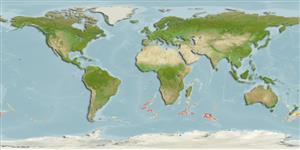分類 / Names
俗名 | 同種異名 | Catalog of Fishes(屬, 種) | ITIS | CoL | WoRMS | Cloffa
Elasmobranchii
板鰓亞綱 (鯊魚與魟魚) (sharks and rays) >
Squaliformes (Sleeper and dogfish sharks) >
Etmopteridae (Lantern sharks)
Etymology: Etmopterus: Greek, ethmos, -ou = sieve or ethmoides bone + Greek, pteron = wing, fin (Ref. 45335); viator: The species is named after the Latin word viator (the traveler), since the species is confirmed for geographically distant locations in the Southern Hemisphere (Ref. 87779).
Environment: milieu / climate zone / depth range / distribution range
生態學
海洋 深海底的; 深度上下限 830 - 1400 m (Ref. 87779).
Southern Ocean: Northern part of the Kerguelen Plateau, off New Zealand and South Africa. Further confirmed for the Macquarie Ridge (P. Last, pers. comm.). It hypothetically occurs in the whole Southern Hemisphere (Ref. 87779).
Length at first maturity / 大小 / 重量 / 年齡
Maturity: Lm 48.0, range 46 - 50 cm
Max length : 39.1 cm TL 雄魚/尚未辨別雌雄; (Ref. 87779); 57.7 cm TL (female)
簡短描述
檢索表 | 型態特徵 | 形態測量圖
脊椎骨: 75 - 84. A medium-sized Etmopterus species with the following combination of characters: body fusiform, caudal peduncle short 0.1 (0.09-0.1) % of total length (TL). Moderately long interdorsal distance 0.19 (0.17-0.24) % TL, very long distance from first dorsal fin spine insertion to snout tip 0.36 (0.36-0.43)% TL. Head long 0.21 (0.21-0.26) % TL and broad 0.1 (0.1-0.15) % TL long, as long as caudal peduncle. Snout short 0.41 (0.40-0.46) % head length (HL) and broad 0.37 (0.34-0.38) % HL. Interorbital distance narrow 0.28 (0.26-0.36) % HL, shorter than snout width. Large oval eyes, eye length 0.26 (0.19-0.26) % HL. Eyes reflect greenish in fresh specimens. Large tear-drop shaped spiracles 0.05 (0.03-0.08) % HL. Mouth strongly arched and broad 0.4 (0.11-0.43) % HL with dignathic homodont dentition . Nostrils large and oblique 0.11 (0.11-0.15) % HL. Gill openings with distinct white margins. Pectoral fins rounded and white-edged with fringed ceratotrichia, moderate in size. Inner margin 0.04 (0.04-0.06) % TL, fin base short 0.05 (0.03-0.06) % TL. Dorsal fins densely covered with dermal denticles, 2nd dorsal fin significantly larger than 1st dorsal fin, height 0.09 (0.10-0.15) % TL compared to 0.03 (0.03-0.05) % TL in 1st dorsal fin. 2nd dorsal fin deeply concave with drawn-out lower lobe. Both dorsal fins fringed, with strong fin spines. The 2nd dorsal fin spine is larger than 1st (broken in the holotype) pointing posteriorly. First dorsal fin originate distinctively behind the pectoral fin insertions, whereas origin of 2nd dorsal fin only sligthly behind pelvic fin insertions. Large heterocercal caudal fin 0.2 (0.19-0.21) % TL with strong upper and weaker lower edged lobes, widely covered with dermal denticles (Ref. 87779).
Life cycle and mating behavior
成熟度 | 繁殖 | 產卵場 | 卵 | 孕卵數 | 仔魚
E. viator is ovoviviparous and gives birth to 2-10 pups per litter. Maturity is reached at approximately 50 cm TL in females and 46 cm TL in males (Duhamel et al., 2005). Males are on average smaller than females, adult females reach at least 58 cm TL, adult males approximately 50 cm TL (Ref. 87779).
Straube, N., G. Duhamel, N. Gasco, J. Kriwet and U.K. Schliewen, 2011. Description of a new deep-sea Lantern Shark Etmopterus viator sp. nov. (Squaliformes: Etmopteridae) from the Southern Hemisphere. The Kerguelen Plateau: marine ecosystem and fisheries. Société Française d'Ichtyologie, Paris, France. Guy Duhamel and Dirk Welsford, Eds. (Ref. 87779)
IUCN 瀕危狀態 (Ref. 130435: Version 2024-2)
無危 (LC) ; Date assessed: 27 June 2017
人類使用
漁業: 沒有興趣
工具
特別的報告
下載 XML
網路資源
Estimates based on models
Preferred temperature (Ref.
123201): 2.1 - 2.2, mean 2.1 °C (based on 6 cells).
Phylogenetic diversity index (Ref.
82804): PD
50 = 0.5000 [Uniqueness, from 0.5 = low to 2.0 = high].
Bayesian length-weight: a=0.00380 (0.00194 - 0.00745), b=3.09 (2.92 - 3.26), in cm total length, based on LWR estimates for this Genus-body shape (Ref.
93245).
營養階層 (Ref.
69278): 4.3 ±0.6 se; based on size and trophs of closest relatives
回復力 (Ref.
120179): 低的, 最小族群倍增時間4.5 - 14 年 (Preliminary K or Fecundity.).
Fishing Vulnerability (Ref.
59153): Moderate vulnerability (43 of 100).
